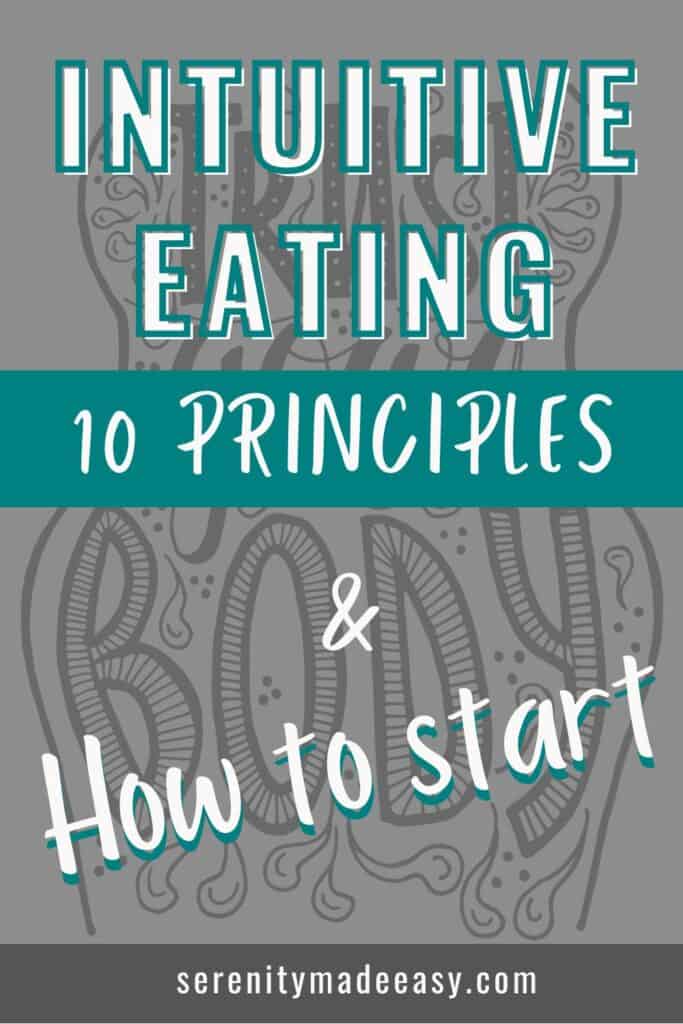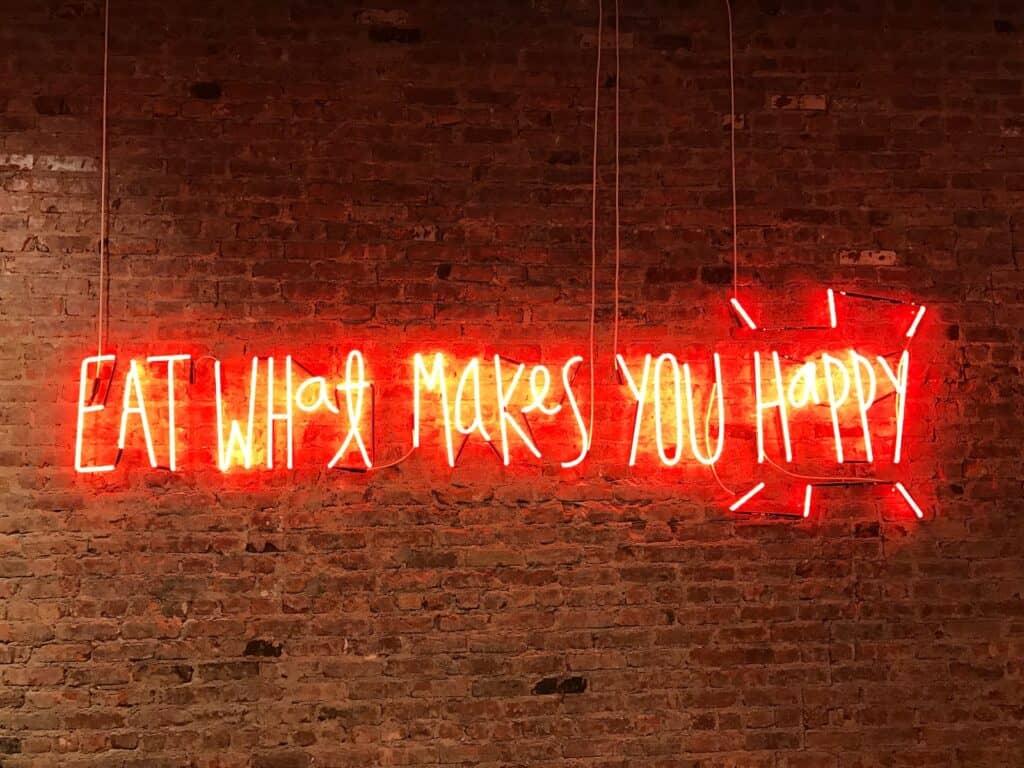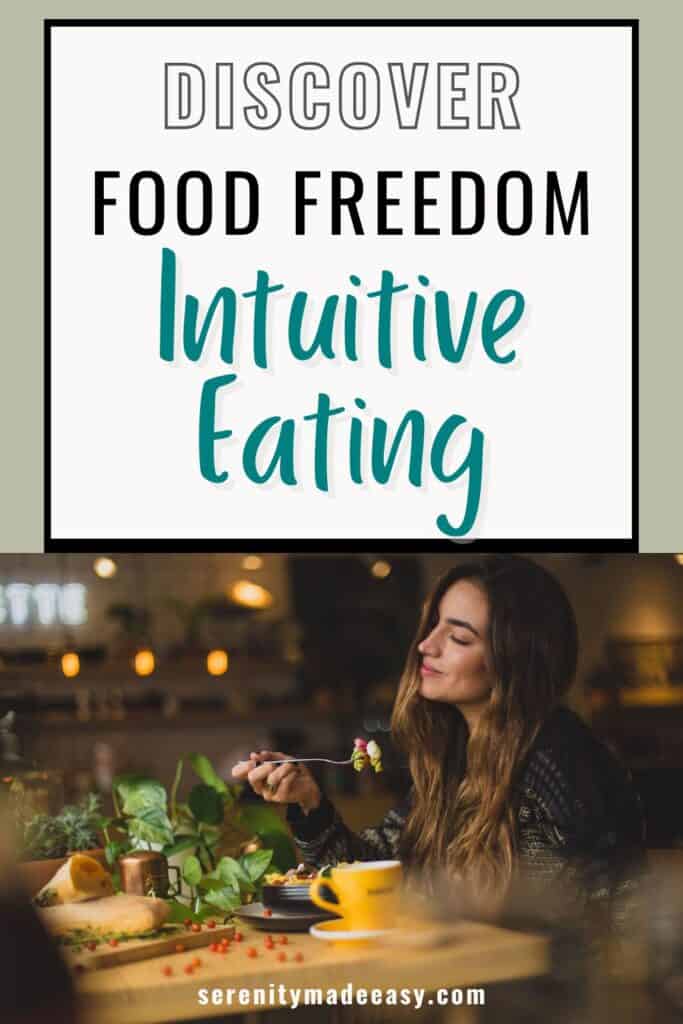This post may contain affiliate links. If you click one and make a purchase, I earn a small commission at no extra cost to you. It helps support the site so I can continue to offer great content to you!

Intuitive eating is not a diet, a method, or a technique. It simply is learning to see food as fuel for our bodies that can and should be enjoyed. It’s about removing the constant thoughts about food and just living. We deserve to enjoy eating delicious food that nourishes our bodies and makes us feel good. Learning how to eat intuitively will transform your life and remove unnecessary stressors from your daily life.
Intuitive eating is not new. Authors Evelyn Tribole and Elyse Resch introduced this concept in 1995 through a book titled “Intuitive Eating: A Revolutionary Program That Works“.
Since its debut, the concept has been the subject of more than 100 research. A more recent study from 2021 indicates a positive correlation to better body image, self-esteem, and well-being.
In this article, we will review the ten principles of intuitive eating. I will share the journey that has led me to intuitive eating and how you can learn to eat intuitively.

10 principles of intuitive eating
1. Reject the diet mentality
We have been conditioned for decades to see food as the enemy that must be controlled. We are shown unrealistic ideal physical looks. With intuitive eating, we throw out diet books, diet concepts, and food rules.

2. Honor your hunger
You would not ignore your need to pee, sleep or breathe. Why do we try to suppress and ignore the hunger signals our bodies send us? Our bodies are designed to know exactly what we need, exactly when we need it. Our bodies are intuitive, and we should listen to them.
3. Stop labeling food
Food is food and should not be labeled as good or bad. It’s time to remove society or self-imposed restrictions. The only bad food is the one that makes you feel unwell. This is different for each of us.
4. Challenge the food police
Silence the voice telling you that you are good or bad based on your food choices. Stop “earning” a cheat meal. This principle is key to becoming an intuitive eater. You have to be willing to call all these unreasonable food rules for what they are. B.S.
5. Discover the satisfaction
Allow yourself to return to (or start) appreciating food. Eat slower and enjoy the textures and the flavors. Discover what is enjoyable to you and welcome this feeling into your life.
6. Feel your fullness

Your body knows just what you need. If you pay attention and use a mindful eating approach, you will know when to stop eating. It’s time to quit the clean plate club. By removing silly rules, you are much less likely to overeat.
7. Recognize your emotions
When reaching for a snack, pause to feel the hunger. You may realize you are not hungry but stressed. Where it’s okay sometimes to eat from an emotional place, there are better mechanisms to cope with each emotion.
8. Accept your genetics
We are born with a pre-dispose body type. There are limitations to what your body can achieve with reasonable efforts. Stop fighting your body to become what it is not intended to do. Love what you were giving.
9. Movement
Discover what kind of movement makes you happy and, more importantly, makes you feel good. Once you find it, do more of it.

10. Incorporate food science
Intuitive eating is not eating everything you want anytime you want. It’s about making food choices that support your health while making you feel your best. Keep a big-picture view and understand that one snack, one meal, or one day is not going to negatively impact your health.
My journey before I learned how to eat intuitively
I came a long way with food and nutrition before learning how to eat intuitively. Over the years, I’ve wanted to be thinner, fitter, and stronger many times.
In my late teen/college age, I was focused on cardio and watching what I ate. I tried to be low in carbs and restricted myself from many foods I enjoyed. I remember going to Subway once a week and only getting a salad so that I “could have” a cookie.
Later, in my 20s and early 30s, I was all about counting calories. I used an app that allowed me to track everything I ate. I remember choosing another glass of wine instead of a snack or more dinner.
I then “progressed” to tracking macros instead of calories. This was also the phase where I wanted to be fit and have muscle definition. I did intense HIIT workouts six days each week, tracked my macros, and ate six times per day (you know, to keep my metabolism high lol!).
Finally, I heard about intermittent fasting and this became my new thing for about 3 years. I did like it a lot. I felt really good doing the 16:8 method. However, I couldn’t help but feel like this was just another restriction. It also made me put a ton of emphasis on food. During my fasting window, I would think about what I would eat in my window. And before my eating window closed, I would have an extra snack in fear of getting too hungry during my fasting window. Ultimately, I did not feel that it was a gentle approach for me.
I decided it was time to learn how to eat intuitively.
How to eat intuitively
1. Remove the temptations
For tracking, that is! I deleted the apps I previously used to track calories and macros.
I also disassociated myself from internet groups that were focused on weight loss, food tracking, or other similar topics.
Lastly, I unfollowed accounts that did not make me feel good on Instagram, YouTube, or elsewhere.
ACTION FOR YOU: Clean your devices from apps and accounts that don’t support your journey.
2. Plan less
I stopped planning every food item I would eat throughout the day. I still do meal planning for dinner because this removes a lot of stress from my life and causes me to waste way less food. However, I no longer decide on every bite of food I will eat at 7 in the morning.
If I am home, I wait to be hungry to decide what to eat based on what sounds good at the moment. I do bring my lunch when I physically go into the office. However, I don’t plan and prepare it until the morning. I also often take a few diverse snacks with me to have options in case I get hungry.
ACTION FOR YOU: Start your intuitive journey on a day (or a few days) when you will mostly be home. Wait to be hungry, but not ravenous to eat. Ask yourself what sounds good when you are hungry and follow what you are drawn to.
3. Change the focus
When I started to learn how to eat intuitively, I removed the scale from my bathroom. I committed to no longer weighing myself. This was the first action in my day, and it would set the tone. If my weight was down, it was a good morning. At one point, I was pretty obsessed with it. This is such an unhealthy habit.
Similarly, I don’t keep tiny pants that used to fit me at 25 years old. If they don’t fit, they go. I fill my closet with clothes that fit me and make me feel good about myself.
ACTION FOR YOU: Remove your scale from easy access and clean your closet. Remove all of your “one day maybe” clothing items and keep a closet full of clothes you love to wear today.
4. Acknowledge and redirect
It takes time to overcome and unlearn the diet mentality. If I catch myself thinking about food rules or reading how many calories are in a food item, I gently redirect. It will happen, and it’s okay, but I don’t let myself stay there.
ACTION FOR YOU: Grab a notebook to journal your thoughts. Each day, reflect on how easy it was to stay away from the diet mentality and food rules. Note if anything, in particular, made it easier or harder today and how you were able (or unable) to cope with it.
5. Develop mindfulness
Intuitive eating is about getting back in touch with your internal signals. Your body knows what you need. Take the time to listen, and you will know just what to eat and when. Sometimes, as you learn, you might confuse a signal. That’s okay. As you continue on your journey, you will become more in touch.
Mindfulness also applies to moving your body. Listen to what you need, and honor what is best for you each day. Don’t worry about never needing to move. Your body needs movement. As you reflect each day, you will see a difference in how you feel and make adjustments to support your well-being.
ACTION FOR YOU: Use your notebook to keep track of how you felt physically and mentally today. Were you energized, bloated, happy, or tired? Notice trends or correlations that might be emerging that can help guide your choices.
6. Don’t worry
The number one fear when people are considering intuitive eating is that their bodies will only want bad food. STOP! Remember, do not label food and reject diet culture and food rules.
Sure, without restrictions, you might be eating a lot of food that was previously “banned” for a while. That’s okay. Listen to your body. Eventually, it will ask for something else, and your nutrition will become more diverse. As you learn how to eat intuitively, you might notice that some previously banned foods are not making you feel good.
Here is something that happened to me around those lines. For years, I tried to incorporate beans and legumes into my diet. I did so because they were “good” for me. I never liked them. A few years ago, I learned that I was allergic to them. That’s why they never felt good to me. My body knew and was telling me all along. I just needed to listen.
ACTION FOR YOU: Add to your journal your joy and satisfaction level as it relates to food for the day. Did you enjoy yourself? What was the most delicious thing you ate today? Did you eat anything that you were disappointed with? Maybe it didn’t taste as good as you hoped. There is no right or wrong, just notice if you enjoyed your day.
In conclusion

Food is energy. It’s there to support your body along this journey called life. It’s also there to be enjoyed. There are so many delicious food options. So many flavors, textures, etc. Learning how to eat intuitively is one of the most caring things you can do for yourself.
I hope this article convinced you to give it a try.
Bon apetit!
Cat xx
